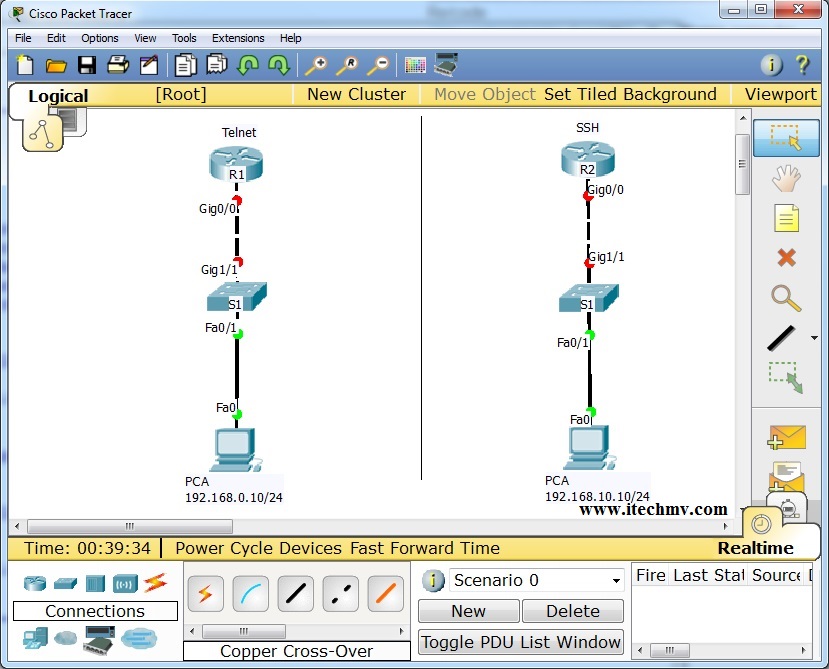
- HOW TO USE TELNET IN PACKET TRACER HOW TO
- HOW TO USE TELNET IN PACKET TRACER SOFTWARE
- HOW TO USE TELNET IN PACKET TRACER PASSWORD
HOW TO USE TELNET IN PACKET TRACER PASSWORD
Enable password authenticates you into privileged executive mode of the terminal device(switch, for example), but you’re using Telnet Password to allow you access the interface of the remote device after connecting to it. Note that Telnet and enable passwords are different.

You can then continue to configure your switch the way you desire( but now, remotely) Now provide the enable password admin (or yours which you set in step 1) to enter the privileged executive mode of the switch. Notice that password characters won’t show up(no echo) on the screen as you type them, but just type, then hit ENTER.Īfter you’re authenticated, you will see the the CLI of the remote switch appear. Now provide the Telnet password that you set in step 3. Hope you remember that 10.0.0.20 is the VLAN address of the switch through which we can access it remotely.Ħ. Go to command prompt of the laptop and type telnet 10.0.0.20 We can establish up to 16 telnet connections to to the switch at the same time. Telnet access to the switch is allowed through VTY lines. Before you can manage the switch remotely via Telnet, you’ll have to provide this password. This password is configured on VTY lines. Switch(config-if)#ip address 10.0.0.20 255.0.0.0Ĥ.Configure a Telnet password for remote access. We assign an IP address to the VLAN interface of the switch so that we can Telnet the switch from the laptop using this address. If you fail to do this,you won’t get past the executive mode of the switch even after you establish a telnet connection to the switch. Configure enable password or enable secret passwordon the switch. We’ll configure Telnet on the switch so that as the admin,you’ll be able to access and manage the switch remotely.Ģ. The topology above consists of an ADMIN laptop and a remote switch. Create the network topology below in Packet Tracer.Īssign the laptop a static IP address of 10.0.0.10. The network administrator will then be presented with a virtual terminal that can interact with the remote host.
HOW TO USE TELNET IN PACKET TRACER SOFTWARE
A user on a client machine can use a software (also known as a Telnet client) to access a command-line interface of another, remote machine that is running a Telnet server program.Ī network administrator can access the device by telnetting to the IP address or hostname of a remote device. Telnet is an application layer protocol that allows a network administrator to access and manage remote devices. Configuring Telnet on a router in Packet Tracer.Configuring Telnet on a switch in Packet Tracer.
HOW TO USE TELNET IN PACKET TRACER HOW TO
Router1(config-line)# transport input noneĪfter this you can only connect to your Cisco device by direct console connection.Welcome to this tutorial! Here, we’ll have have an overview of the Telnet then see how to configure it on a switch and a router in Packet Tracer. Sometimes you want to disable all forms of remote access (Telnet and SSH).

This disables telnet and enables ssh on all the 16 VTYs. On IOS 12.2 and up 16 simultaneous connections are allowed. On earlier platforms five simultaneous remote connections are allowed and these are vty 0 to 4. This disables telnet and enables ssh on all the five VTYs (Virtual Terminal Lines)

Router1(config-line)# transport input ssh To disable Telnet and enable only SSH connections:įirst login to the Cisco Switch or Router and enter configuration mode

This article demonstrates how to disable Telnet Protocol on a Cisco Router ( the same applies to all Cisco IOS devices) It is recommended to use SSH for remote access as this gives you secure, encrypted connection to your Cisco device. However it is not very secure to enable Telnet on your Cisco device as the login information and commands are sent in clear text and can be easily hacked. Telnet protocol enables users to remotely connect to Cisco devices and it is enabled by default on most Cisco device.


 0 kommentar(er)
0 kommentar(er)
